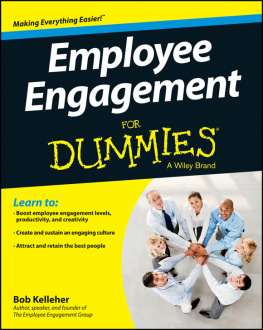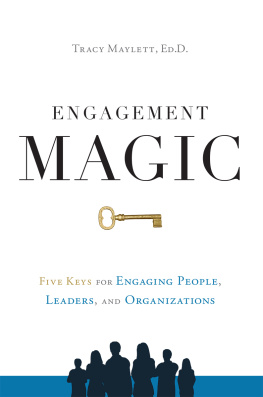CULTIVATING ENGAGED STAFF
Better Management for Better Libraries
_______________
Margaret Zelman Law

Copyright 2017 by Margaret Zelman Law
All rights reserved. No part of this publication may be reproduced, stored in a retrieval system, or transmitted, in any form or by any means, electronic, mechanical, photocopying, recording, or otherwise, except for the inclusion of brief quotations in a review, without prior permission in writing from the publisher.
Library of Congress Cataloging-in-Publication Data
Names: Law, Margaret Zelman, author.
Title: Cultivating engaged staff : better management for better libraries/Margaret Zelman Law.
Description: Santa Barbara, California : Libraries Unlimited, an Imprint of ABC-CLIO, LLC, [2017] | Includes bibliographical references and index.
Identifiers: LCCN 2017004832 (print) | LCCN 2017039284 (ebook) | ISBN 9781440852237 (ebook) | ISBN 9781440852220 (paperback : acid-free paper)
Subjects: LCSH: Library personnel management. | Library employeesAttitudes. | Library employeesIn-service training. | LibrariansProfessional relationships | Organizational behaviour. | Employee motivation.
Classification: LCC Z682 (ebook) | LCC Z682 .L39 2017 (print) | DDC 023dc23
LC record available at https://lccn.loc.gov/2017004832
ISBN: 9781440852220
EISBN: 9781440852237
21 20 19 18 171 2 3 4 5
This book is also available as an eBook.
Libraries Unlimited
An Imprint of ABC-CLIO, LLC
ABC-CLIO, LLC
130 Cremona Drive, P.O. Box 1911
Santa Barbara, California 93116-1911
www.abc-clio.com
This book is printed on acid-free paper 
Manufactured in the United States of America
For Michael
19742014
Contents
Acknowledgments
It takes a village, or at least a community, to write a book. This book would not have been possible without the support and encouragement of friends and colleagues around the world. Their willingness to discuss practical applications, to share their stories, and to provide feedback have all contributed to the final product. Without the backing of Dr. Kay Devine, of Athabasca University, the research behind this work would never have been completed. My sincere thanks and gratitude.
A more formal thank you to my employer, the University of Alberta Libraries, for granting me a leave in order to write, and to my colleagues there for providing me with endless library service.
It all combines to remind me of one of the most positive aspects of librarianship: the commitment to collaboration.
Introduction: Employees and Their Relationships with Work
Any manager would love to work with engaged colleagues, ready and eager when they come to work, looking ahead to the challenges and rewards of the day. Every manager knows, however, that this is not always what happens. Some days it seems like staff members drag their reluctant bodies to work, leaving their hearts and souls at home. What are the causes of this malaise? In some cases it is a result of individual differences, but much of it is shaped by the working environment.
Part of the enigma employee engagement results from within the individual employee and reflects choices, priorities, and even personality. A larger part rests with the workplace, with the general climate of the organization, with policies and procedures, and with the behavior of different levels of management. This is the part that any manager can influence, and this is the aspect of employee engagement to which managers should pay attention.
Employee disengagement, a sense of reduced passion and energy that individuals bring to work, appears to be an increasingly common experience among North American workers. In the United States alone, it is estimated that disengagement results in the loss of several billion dollars each year in the business and commercial sector as a result of reduced levels of energy applied to work leading to reduced productivity. Similar results have been found in studies worldwide, from such disparate places as Bangladesh, Korea, and Romania. Although library and information organizations do not lose money, they still suffer from the loss of staff energy and enthusiasm. Engagement is defined in many ways, but one of the most widely used definitions is the extent to which an employee is physically, cognitively, and emotionally involved in the performance of his or her job and demonstrates this through energy, dedication, and absorption in the job (Gonzlez-Rom, Schaufeli, Bakker, & Lloret, 2006). This is the definition that is used throughout this book.
As a result of its impact on productivity and absenteeism, employee engagement has become a major consideration for managers. In a 2014 study, 78% of U.S. business leaders identified engagement as urgent or important to their success, but almost none had developed any strategies to address it or to analyze their organization to discover factors that might have a negative impact on employee engagement. A large-scale study in Great Britain found that only about a third of employees felt actively engaged at work (Galagan, 2015). Clearly, both managers and employees feel that there is a significant proportion of the workforce that is not working to full capacity or reaching their full potential as defined by either managers or employees.
Why does employee engagement matter in library and information environments? The work that is done in this industry is primarily service-based, even as emerging technologies and changing user expectations lead to its evolution. Employees are one of the major assets of every library and information service; they evaluate the needs of the community, they develop and implement services, and they deliver them either face-to-face or through electronic formats. Like any other resource, human resources need to be managed in the most effective way so that they can be productive as well as healthy and committed to their work. Engaged employees make the library or information service more effective and more efficient, resulting in satisfied customers, satisfied managers, and satisfied funders.
EMPLOYEE ENGAGEMENT
Engaged employees are those who bring energy, dedication, and absorption to their work. They are not only physically there but are also intellectually and emotionally involved in their jobs (Gonzlez-Rom et al., 2006). It includes three separate components: vigor, dedication, and absorption. Vigor refers to high levels of energy that an employee brings to work, resulting in the investment of effort and persistence when things become challenging. Dedication refers to the sense of being highly involved with work, related to feelings of enthusiasm and pride in accomplishments. Absorption is a description of the sense of being completely drawn into an activity so that time passes quickly.
A quick Internet search or a few minutes spent browsing the magazine stands at a local store will show many ways for managers and organizations to increase levels of engagement among employees to an optimal level. Many of these sites and articles, however, confuse employee engagement with other concepts such as job satisfaction, motivation, organizational culture, and mental health. While these are all interrelated, and employee engagement plays a role in all of them, it is necessary to distinguish among them. In order to introduce these ideas so that we can explore their relationship with employee engagement, a number of definitions are provided in this chapter.










